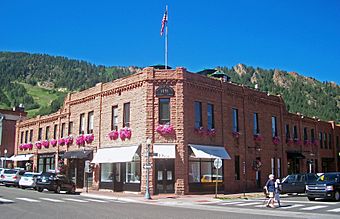Brand Building facts for kids
Quick facts for kids |
|
|
Hyman–Brand Building
|
|

East and north elevations, 2010
|
|
| Location | Aspen, CO |
|---|---|
| Built | 1891 |
| NRHP reference No. | 85000085 |
| Added to NRHP | January 18, 1985 |
The Hyman–Brand Building, also known as the Brand Building, is a historic two-story stone building in Aspen, United States. It stands at the corner of South Galena Street and East Hopkins Avenue. Built in 1891, this building has played a big role in Aspen's history.
Over the years, different business owners used the building in ways that changed the city. It was first a bank, then a car dealership and gas station. Later, in 1971, a local business person named Harley Baldwin saved it from being torn down. He helped turn it and the nearby Collins Block into a fancy shopping area known as "Glitter Gulch." Today, the Hyman–Brand Building is home to high-end shops and art galleries. In 1985, it was added to the National Register of Historic Places, which means it's recognized as an important historical site.
Contents
About the Building
The Hyman–Brand Building is located in a busy part of Aspen. It's across the street from Aspen City Hall and next to the Collins Block, both of which are also historic buildings. The area around it has many old and new commercial buildings, usually two or three stories tall.
The building is made of brick walls covered with rough, pinkish-orange sandstone. It has two floors. A special entrance on the corner connects the two main sides of the building. The side facing Galena Street has 12 window sections, and the Hopkins Avenue side has 10.
Flat columns, called pilasters, separate parts of the building's front. Most of the ground floor has retail stores. Their entrances are often covered by awnings. Famous brands like Dior and Gucci have shops here. An art gallery is also located on the ground floor.
The second floor has many windows. These are tall, double-hung windows, meaning they open by sliding up and down. The corner window on the second floor has a special semicircular sign that says "BRAND BLDG. 1891 ASPEN COLO." Above the second floor is a decorative ledge, called a cornice. On top of the building, there's an open-air cafe with umbrellas. A flagpole stands proudly above the corner.
Inside, the first floor is used for shops. The second floor has hotel rooms. Many of these rooms still have their original wooden details. In the Dior shop, you can still see the original bank vault and its decorated door from when the building was a bank.
Building's History
Early Days and the Silver Boom
The Hyman–Brand Building was built by David Marks Hyman. He was a lawyer from Bavaria, Germany, who studied at Harvard University. In the early 1880s, he came to Aspen to manage his investments in silver mines. He became one of the wealthiest people in Aspen during the Colorado Silver Boom.
Hyman, like another important Aspen developer named Jerome B. Wheeler, built large buildings to show his success. The Hyman Building used the same pinkish-orange sandstone as Wheeler's Opera House. This stone was brought to Aspen by railroads, which Hyman and Wheeler had worked together to bring to the Roaring Fork Valley.
The Hyman Building was one of the biggest commercial buildings in Aspen during the silver boom. It cost $30,000 to build, which was a lot of money back then. It was as large and important as the Aspen Block, another major building in the city. Both buildings shared a main tenant: the First National Bank of Aspen. The bank was in the corner space of the Hyman Building. Other shops, like jewelers and a grocery store, were also tenants. The upper floor had offices and a large meeting hall.
Surviving Tough Times
The bank's presence and the building's important location helped it survive after the Panic of 1893. This event caused the price of silver to drop, ending Aspen's boom years. Many smaller buildings from that time became empty and fell apart. But the Hyman Building stayed important. The meeting room on the upper floor became a popular place for local dances.
In the 1920s, another business person named Michael H. Brand bought the building. He changed it to serve the growing number of cars in Aspen. The corner space, which used to be the bank lobby, became a service station. It had high ceilings, perfect for trucks. Other parts of the building became a car dealership and repair shop.
Modern Era and "Glitter Gulch"
After World War II, Aspen slowly became a famous ski resort, and its economy improved. In the 1950s, the Aspen Music Festival and School used the building's meeting hall for orchestra rehearsals. By 1970, the gas station was no longer doing well, and the building was almost torn down.
But in 1971, Harley Baldwin bought the building for $170,000. Baldwin was a young man who had moved to Aspen and started a successful real estate business. He fixed up the Hyman–Brand Building and rented it out to shops.
Later, in 1988, Baldwin bought the Collins Block next door. He began to transform both buildings into symbols of Aspen's luxury. He replaced older shops, like a hardware store, with high-end fashion stores like Louis Vuitton, Dior, and Gucci. Baldwin also opened his own art gallery in the building. The second floor of the Hyman–Brand Building became the exclusive Aspen Hotel.
This area became known as "Glitter Gulch." Some people in Aspen missed the simpler times, but Baldwin believed that Aspen was meant for successful people who enjoyed luxury. When he passed away in 2005, the Hyman–Brand Building was worth about $15 million.


